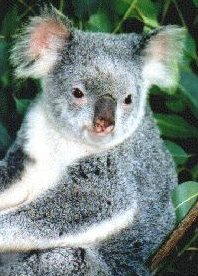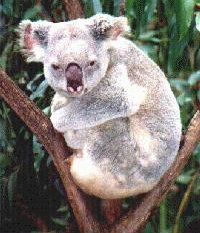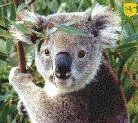|
|
|
The Australian Koala Foundation (AKF) |
|
 |
How do they live?
How do they
communicate? |
|
Koalas live in societies, just like humans, so they need to be
able to come into contact with other koalas. Because of this
they need to have areas of suitable eucalypt forest which are
large enough to support a healthy koala population and to allow
for expansion by maturing young koalas. |
|
"Habitat" refers to the
types of bushland that koalas like to live in. They are found in
a range of habitats, from coastal islands and tall eucalypt
forests to low woodlands inland. Today, they do not live in
rainforest, although it is thought that millions of years ago,
the ancestors from which today's koalas
evolved lived in the
rainforests which covered much of Australia at that time. |
|
Facts vs Myths |
|
* |
Koalas are marsupials.
They carry their young in a
pouch. Koalas are NOT bears. |
|
* |
The greatest
threat facing wild koala populations today is the destruction and
fragmentation of their habitat. |
|
* |
Since white settlement of
Australia approximately 80% of the koala’s habitat has been
destroyed. Of the
remaining 20% almost none is protected and
most occurs on privately owned land. |
|
* |
Stopping trees from being
cleared in the first place and protecting existing koala habitat
is the most effective way to conserve koalas. |
|
* |
Koalas have specific,
specialised habitat requirements which include the presence of
other koalas in the first instance, followed by the presence of
preferred food trees.
Wild koalas arrange
themselves in socially
stable breeding groups where each koala
has its own home range. |
|
* |
Koalas are territorial
animals. They do not
wander aimlessly through the bush. |
|
* |
Koalas store little or no
fat. |
|
* |
Koalas must adopt
strategies that conserve energy. Sleeping is one of them. |
|
|
A little history |
|
Koalas or koala-like animals
probably first evolved on the Australian continent during the
period when Australia began
to drift
slowly northward, gradually
separating from the Antarctic land mass some 45 million years
ago.
Fossil remains of koala-like animals have been found dating
back to 25 million years ago.
As the climate changed and
Australia became drier, vegetation altered until what we
recognise as eucalyptus, or
gum trees, evolved and koalas became
dependent on them for food.
|
 |
|
|
How koalas
communicate |
|
Koalas use a
range of sounds to communicate with one another over relatively
large distances. There is a deep
grunting
bellow
which the male uses to signify its social and physical position.
Males save fighting energy by bellowing their dominance and they
also bellow to allow other animals to accurately locate the
position of the caller. Females do not bellow as often as males,
but their calls too are used to express aggression as well as
being part of sexual behaviour, often giving the impression of
fighting. Mothers and babies make soft clicking, squeaking sounds
and gentle humming or murmering sounds to one another, as well as
gentle grunts to signal displeasure or annoyance. All koalas share
one common call which is elicited by fear. It is a sickening cry
like a baby screaming and is made by animals under stress. It is
often accompanied by shaking. Koalas also communicate by marking
their trees with their
scent.
|
|
What is happening
to koala habitat? |
|
Since European settlement,
approximately 80% of Australia's eucalypt forests have been
decimated. Of the remaining 20% almost none is protected and
most occurs on privately-owned land. Settlers have favoured the rich
fertile lands along the eastern
seaboard to have their farms and
urban developments. Unfortunately, this is where the majority of
koalas are already living because they also like to live in
trees which are growing in fertile soils.
|
|
How many are left
and where are they? |
|
Results from
the AKF's Koala Habitat Atlas deliver a
grim picture about the status of koala
populations in all regions studied
so far.
Available habitat was found
to be fragmented and degraded, and in many areas of suitable
habitats, the koalas themselves were found to be absent.
The AKF believes that the national wild koala population has
dropped to less than 100,000, a far cry from the millions which
were shot in the 1920's for their furs. At the present rate of
destruction of habitat, and with up to 4,000 koalas presently
being killed each year by cars and dogs, it is obvious that time
is
running out. Action is
needed now to halt this alarming decline in koala numbers.
|
|
What is being
done to help? |
 |
While things look grim for the
koala, there are many people already helping to ensure that this
beautiful native animal survives for future generations. Many
local koala groups are keeping vigilant in their area about
destruction of habitat and are
taking care of sick, injured and
orphaned koalas so that they can be released back in the wild
where they belong. |
|
|
However, we
must ensure that koalas and other healthy animals have undamaged
habitat to live in. There is little point in making a koala
well, only to release it back into damaged habitat or habitat
which is
at
risk of destruction,
if we aren't at the same time doing everything possible to
preserve what habitat remains. It is very likely to come back
injured, sick or dead
at a
later date. |
|
Photos 1 and 2: Ann
Sharp (taken at Koala Lone Pine Sanctuary)
-
Photo
3. Philip
Wright |
|
GLOSSARY |
|
evolved:
developed (se desarrollaron)
pouch: pocket or small sac (bolsa)
threat: danger (peligro)
remaining: the rest (restante)
stable: not variable (estable)
wander: going everywhere in freedom (andan)
fat: grease (grasa)
to drift: to move (desplazarse, movilizarse)
gum trees: Eucalyptus or Liquidambar trees (árboles
resinosos como eucaliptos o liquidámbar)
grunting bellow: koalas's shout (gruñido) |
scent: distinctive
odor, perfume (olor)
decimated: killed in large numbers, eliminated (destruidos,
eliminados)
seaboard: shore of sea or ocean (plataforma marina)
grim: depressing, gloomy (lamentable)
so far: up to now, until now (hasta el presente)
running out: ending, finishing (extinguiéndose)
taking care of: looking after, taking charge of (haciéndose
cargo de, cuidando)
at risk: in danger (en peligro) |
|
|
|
|
 |
|
MAS "ECOLOGIA - VIDA SILVESTRE"
FORO
INICIO |